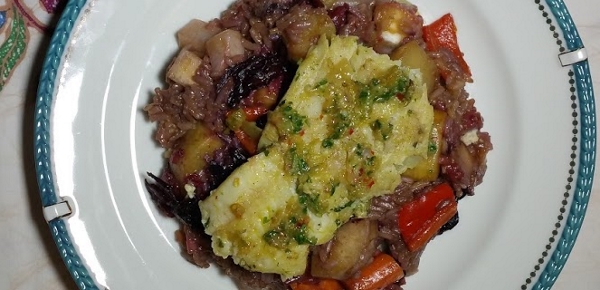
Thiéboudienne (French) or Ceeb ak Jën (Wolof) is a one-pot, tomato-based fish and vegetable dish and the national dish of Senegal. Senegal is a west African country that is home to numerous ethnic groups. It is believed that the dish originated on the Senegalese island of St. Louis. Until 1957, St. Louis was the capital of Senegal and is now a UN World Heritage site. It has been suggested that dishes like Thiéboudienne, enjoyed widely in Senegal, help forge a national identity in the context of a widely diverse country. The five large groups in order of population are Wolof, Fula, Sere, Jola, and Mandinka. Although the most widely spoken language is Wolof, being a former colony, the official language is French. Despite linguistic differences, these groups are culturally similar, and marriage between groups is very common. The capital city of Dakar is famous for its nightlife and many kinds of music, but most popular is the national music known as Mbalax which is a fusion of indigenous drum music with Western music (jazz, soul, Latin, rock).width=100%>Thiéboudienne is a fish, rice, tomato and vegetable dish that is cooked in a single pot. There are lots and lots of variations, and many kinds of fish and vegetables are used, whatever is most available. In her book entitled "High on the Hog: A Culinary Journey from Africa to America," Jessica B. Harris states that there is a direct historical connection between Thiéboudienne and Charleston Red Rice. It is also similar to Jollof Rice found in Ghana, Mali and Nigeria. Fish can be cooked in fillets (skin on or off), chunks, or even whole. Although added to the pot later, the fish is often stuffed with an onion and parsley paste and cooked separately. Vegetables used include onions, lettuce, cabbage, turnips, squash, pumpkin, carrots, eggplants, cabbage, cassava, okra and just about any kind of peppers. Bullion, often Maggi Nokoss contains onion and hibiscus flavors as well as MSG [Check]. Tamarind adds some sourness, but the dish can also be served with lime wedges to achieve a similar result. Hibiscus flowers or powder, called bissup is an important ingredient. Dried hibiscus flowers are also known as Jamaica and are available at Specialty Produce. Hibiscus originated in China, but it has been traded throughout the world for the past 300 years. The other somewhat unusual ingredient is cassava root, otherwise known as yuca root, and it can also be purchased at Specialty Produce. The recipe below uses fish sauce to add umami flavor instead of MSG based bouillon, but depending on your preferences, you can use either. Traditionally Thiéboudienne is eaten by several people from a common platter.
Ingredients:
Stuffing for the fish (roof or roff)
- 1/2 cup parsley stems removed and chopped fine
- 1 teaspoon crushed red chile flakes
- 6 cloves garlic, crushed or minced
- 2 scallions, chopped fine
- 1 small yellow onion chopped fine
- Salt and pepper to taste
- 1 pound of fish (variety cook's choice)
For the Thiéboudienne (in order they are used)
- 1/3 cup of cooking oil (red palm oil is most authentic)
- 2 medium yellow onions, roughly chopped
- 2 medium bell peppers (green, red or yellow), chopped roughly (remove stems and seeds first)
- 4 cups fish, chicken or vegetable stock
- 1 cup tomato puree
- 2 tablespoons tamarind paste
- 2 tablespoons fish sauce
- 1/3 cup dried white hibiscus flowers (aka Jamaica) soaked in boiling water
- 3 cups rice (your choice of type)
- 1 half of an acorn squash (1 inch cubes)
- 3 carrots cut into large chunks
- 1 turnip cubed
- 1 cassava (aka yuca) root, peeled and cut into chunks
Preparation:
- Finely chop the de-stemmed parsley, scallions and onion, and then mix together with the chilie flakes, crushed garlic and some salt and pepper.
- Cut up, chop or slice the vegetable ingredients mentioned above.
- Chop the dried Hibiscus flowers medium fine.
- Soak the dried Hibiscus flowers in 1 cup of hot water.
- In a large pot or Dutch oven, saute in the oil the chopped onions, bell peppers until soft.
- Add the fish (chicken, or vegetable) stock to the pot.
- Stir in the fish sauce, hibiscus flowers (with the water they are soaking in),tomato puree and tamarind to the stock.
- Add the rice to the pot.
- Add the remaining cut up roots and vegetables to the pot.
- Bring pot to a boil and then bring down to a very low simmer.
- Be sure to frequently check with a spoon or spatula to ensure the dish doesn't burn on the bottom.
- Make fairly deep slashes (or punch holes) in the fish.
- Stuff the slashes or holes in the fish with with chopped parsley-onion.
- In a pan, fry the fish on both sides in some oil.
- The rice and vegetables will take about 30 minutes to cook. 10 minutes before the end, gently place the fish on top of the other ingredients in the pot.
- When the rice and vegetables are fully cooked, remove from heat and serve.
Cook's notes:
- This recipe is heavier on the quantities of cassava, turnip, and squash than would be typical for this dish. For this size preparation, an authentic quantify of these items would be half or even a quarter as much indicated. This was done to avoid having to save halves of these items (although we did that for the squash).
- Many recipes call for using tomato paste instead of puree. Doing so will increase the likelihood that the dish will burn on the bottom of the pot, so more care is required.
- In Senegal Thiéboudienne is often served on a large communal platter with four to five people seated cross-legged around the platter. Traditionally diners eat with their hands.
Recipe: T. Johnston-O'Neill
Photo: Shari K. Johnston-O'Neill








